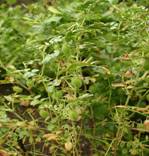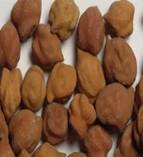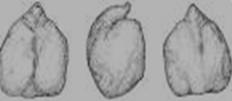AGR 301 :: Lecture 05 :: RABI PULSES CHICKPEA
![]()
Rabi season pulse or Cool season food legumes are:
- Chickpea, Filed pea, Lentil, , French bean
- They contribute 60% world pulse production
- 28 million ha globally
- They are concentrated on temperate and sub-tropical climate
- Chickpea, lentil in developing countries
- Peas in developed countries
CHICKPEA / BENGALGRAM - Cicer arietinum
- Cicer derived from ‘Cicero’ well known Roman family and ‘arietinum’ from ‘aries’ meaning ram’s head shape
- Gram, Bengal gram, chana
- Mostly used pulse in many products
- Boiled, roasted, steamed, sprouted, flour made into many delicious food




World Scenario
Country |
Million ha |
Million t |
t/ha |
Africa (Ethiopia, Malawi, Morocco, Tanzania, Tunisia) |
0.41 |
0.32 |
0.79 |
Mexico |
0.11 |
0.16 |
1.44 |
Asia (India, Pak, Turkey, Iran, Myanmar) |
9.82 |
7.37 |
0.75 |
India |
6.93 |
5.60 |
0.81 |
Europe |
0.05 |
0.04 |
0.93 |
Australia |
0.09 |
0.11 |
1.09 |
World |
10.67 |
8.24 |
0.77 |
Indian Scenario
State |
c |
Production |
Productivity (kg/ha) |
MP |
2560.7 |
2371.2 |
926 |
Rajasthan |
1081.1 |
478.9 |
443 |
UP |
739.6 |
660.6 |
893 |
Maharastra |
1020 |
705 |
691 |
Haryana |
130 |
72 |
554 |
Karnataka |
418 |
229 |
548 |
AP |
394 |
627 |
1591 |
All India |
6896.2 |
5575.4 |
808 |
(Ministry of Agriculture, Govt. of India, 2005-06)
- Origin
Gram is cultivated in India from a longer period. It is originated from South West asia or eastern Mediterranean. It is cultivated in Iran, Turkey,Central and Southern Africa, Rumania and Egypt.
- Varieties
- Two types Desi & Kabuli
- Desi is small seeded
- Angular shaped edge
- Shape like chickens head
- 90% of the world’s cultivated
- Kabuli, large and round seeded with white pale cream seed coat
- Duration 90-180 days
- CO 2, CO 3, CO 4 are 90days
- All India – many varieties , Vijay, Pusa 391, DCP 91-3 (HYV, High input response, 150d, 170mg seeds size)
- Climate
- Comes well under dry tracts with an annual rainfall of 600 – 1000mm.
- Soil
- Sandy loam to clay loam soil.
- Field preparation
- One deep ploughing followed by two harrowing
- Crop needs clodded and rough seed bed for aeration in root zone.
- Sowing
- Second fortnight of October to first week of November
- Seed rate
- 75 -100 kg/ha, depth of sowing – 8 to 10cm
- Spacing – 30 cm between rows for Desi types
4o to 45 cm for Kabuli types
- Nutrient management
Crop |
Ecosystem |
Planting time |
N |
P2O5 |
K2O |
S |
Chickpea |
Rainfed |
Normal |
20 |
40 |
0 |
20 |
|
Irrigated |
Normal |
20 |
60 |
20 |
20 |
|
|
Late |
40 |
40 |
20 |
20 |
- Weed management
- 2 hand weedings at 25 to 30 DAS and after 60 DAS
- Basalin @ 1 kg a.i/ ha as pre emergence + 1 hand weeding at 60 DAS
- Water management
- Light irrigation at flowering and grain development stage.
- Nipping
Plucking the apical buds of the crop at about 30 to 40 DAS is done to stop the apical growth. It promotes the lateral branching, plants to become more vigorous and produce more vigorous and produce more flowers and pods and yield per plant is increased.
- Harvesting
The matured plants are cut and dried under direct sun. The dried plants are threshed using sticks to separate the grains.
- Grain yield
Desi types – 1.5 to 2 t/ha
Kabuli types – 2.5 to 3.5 t/ha
Multiple choice questions
- Centre of origin of chick pea is ___________
a. America b. S. Africa c. S.W.Asia - The inflorescence of chick pea is ________
a. Axilary raceme b. Panicle c. Ear - The recommended seed rate for chick pea is __________
a. 8-10 kg/ha b. 15-20 kg/ha c. 75-100 kg/ha - Most critical stage of irrigation for chick pea is ________
a. Tillering b. CRI c. Pre flowering - The leading producer of chick pea is ________
a. India b. Burma c. Bangladesh - Photoperiodically, chick pea is a type of plant is ________
a. Short day b. Long day c. Day neutral - Chick pea belongs to the family
a. Tiliaceae b. Leguminoceae c. Linaceae - Ideal temperature for sowing of chick pea is
a. 15-200c b. 10-250c c. 10-150c - The recommended seed rate for kabuli gram is _____kg/ha
a. 20-25 b. 100-125 c. 8-10 - Nipping in chick pea is a process of
a. To enlarge branching
b. To reduce plant height
c. To protect plants against lodging
| Download this lecture as PDF here |
![]()